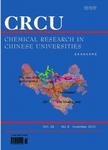Interaction Between 1,2,3-Trichloropropane and Haloalkane Dehalogenase LinB
Interaction Between 1,2,3-Trichloropropane and Haloalkane Dehalogenase LinB作者机构:State Key Laboratory of Theoretical and Computational ChemistryInstitute of Theoretical ChemistryJilin University
出 版 物:《Chemical Research in Chinese Universities》 (高等学校化学研究(英文版))
年 卷 期:2009年第25卷第4期
页 面:556-559页
核心收录:
学科分类:081704[工学-应用化学] 07[理学] 08[工学] 0817[工学-化学工程与技术] 070303[理学-有机化学] 0703[理学-化学]
基 金:Supported by the National Natural Science Foundation of China(No.20573042) Key Projects in the National Science & Technology Pillar Program of China(No.2006BAE03B01) Specialized Research Fund for the Doctoral Program of Higher Education of China(No.20070183046) Specialized Fund for the Basic Research of Jilin University,China(No.200810018)
主 题:Haloalkane dehalogenase 1,2,3-Trichloropropane Docking Molecular dynamics simulation
摘 要:The haloalkane dehalogenase LinB from Sphingomonas paucimobills UT26 was found to transform the 1,2,3-trichloropropane(TCP) into inorganic halide ions and 2,3-dichloro-1-propanol although the catalytic activity is very low(Kcat=0.005 s^-1).In this study,molecular dynamics simulation and docking studies were performed to investigate the binding of TCP to *** docking results indicate that LinB does not restrict TCP to be bound productively in the active site and the water-mediated inhibition occurs in the process of TCP interacting with *** residues Ile134,Leu150,Phe154,Pro208,and Ile211 located on the cap domain are potential targets for mutagenesis researches.



